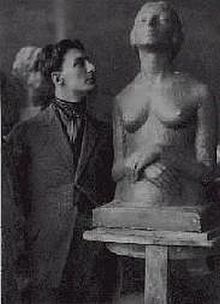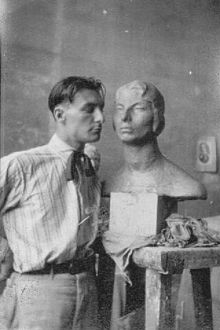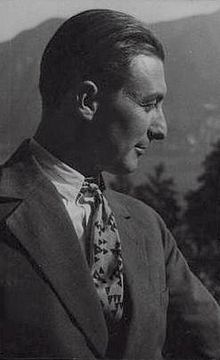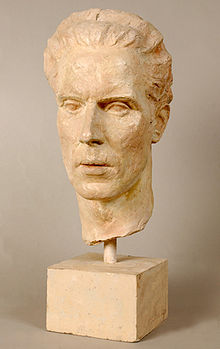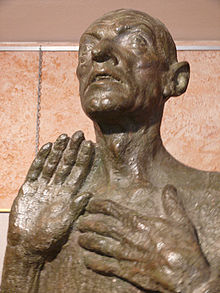- Mario Bernasconi
-
Mario Bernasconi (Pazzallo, February 13, 1899 - Viganello, March 19, 1963) was a Swiss-Italian sculptor. Art critics and historians of the twentieth century wrote:
"Mario Bernasconi is a fine and original artist who has worked hard. The projects in his studio stand to demonstrate not only a distinguished artist, but a great artist!". quote translated from french[1]
"The art work and the personality of Mario Bernasconi, one of the maximum sculptors of the period, have not yet been object of deep studies, which constitutes a serious gap for the comprehension of the southern Swiss artistic reality of the first half of the 20th century." quote translated from Italian[2]
Contents
Biography
Mario was born in 1899 in Lugano-Pazzallo, in the home facing the Museum. Son of Luigi Bernasconi (electrician) and Caterina Dozio (seamstress). He grew up with his sister Maria (Nini) who was two years younger. The family lived in modest conditions.
He was attracted to what he called "la mia montagna" (my mountain) the San Salvatore. On the mountain, Mario discovered the clay and received his first inspirations. During his childhood, beside the school there was the country life. The child brought home lizards, snakes, insects of every kind, whom he studied and observed attentively.
Work and Study
1914 - Once the obligatory schools terminated and having to learn a trade, Mario works in a pharmacy in Lugano. In the evening he poses as a model in the studio of the sculptor Luigi Vassalli. Captured by the arts, Mario leaves the pharmacy and becomes a student of Vassalli. In addition to posing and performing hard work, he learns the art of molding, the design in relief and the study of the human body. In carving marble and shaping clay he is more than ever convinced to become a sculptor. 1917 - Mario continues his studies by the painter and sculptor Giuseppe Foglia and starts his own studio in Pazzallo, in the house that is now the Mario Bernasconi Museum. In that cellar or barn, Mario creates his best works of art. In his studies Mario is deeply inspired by Michelangelo, Donatello, Rodin, Maillol and Lehmbruck. [3]
Giuseppe Curonici wrote in the introduction of the volume Mario Bernasconi Salvioni Arti Grafiche, Bellinzona, May 2005) (translated from italian) “We believe that the naturalistic image presence in the human figure by Mario Bernasconi is on one side a permanence of the ancient post-classical, a traditional act; but on the other side it may also be an act of contemporary reflection, just so because it is one of the voices in modern pluralism. The post- classical naturalism is present in the Italian culture throughout the clima of the twentieth century, in particular we can contemplate the early work of Marino Marini (who knew German art directly) In French culture, it is the name of Maillol, and others. As for German culture, a master of figurative sculpture that Mario observed is Lehmbruck, and others, of course, even in fields far from his own: He loved Klee’s paintings. Mario Bernasconi lived in Germany from 1927 to 1929, after his marriage to Irma Pannes. The linearity and the expressive imaging of many portraits, especially feminine, originated from the various experiences that we will so summarize: naturalism, classical tradition, and technical mastery, twentieth-century Europe. As a man and citizen, Bernasconi had a strong psychological and social sensitivity, as an artist, the apparent visible simplicity in his approach contains a secret but intense complexity and depth, that gone time has not erased, on the contrary it helps us to better understand." [4]
Early Works and Scholarships
Mario obtains the first Federal scholarship that was renewed for three consecutive years:
1921 - the mask "La scema" (The idiot).[5] 1922 - the portraits of "Enea and Eva". 1923 - the bust "La giovane madre" (The young mother).
He makes the portrait of his friends, among them Angelo Tonello, the painters Filippo Boldini, Gualtiero Colombo, the writers Vinicio Salati Francesco Manzoni and Silvio Calloni the distinguished naturalist from Pazzallo.
He creates the head of "Cristo" (Christ) that stands atop the steps of San Pietro Pambio Cemetery, at the center of the big stone cross.
1923 - His mother becomes ill and dies. A period of inertia follows, but it's the portrait of his mother that brings back his creativity.
1925- At the National Exhibition of Fine Art at the Kunsthaus Zurich, the Federal Government acquires the statue "Il Curato di campagna" (The country Priest) and donated the bronze to the city of Lugano
The full plaster figure can be seen at the Museo in Pazzallo. On June 13, 1926 in New York, on the Daily News of the workers of America, "The New World" in the center of the front page appears the reproduction of the sculpture "Il Martire" (The Martyr) by Mario Bernasconi. It was Giacomo Matteotti, which in New York on that day, the second year of his tragic death was commemorated. Bernasconi donated later this sculpture to the Chamber of Labor in Lugano.
Career, Character, Marriage and Travel
The artist demonstrates to be a free-thinker, a great lover of nature, mystic, philosopher, intuitive, poet, romantic. His family and friends considered him to be gentle and having a good character, a bit narcissistic, sentimental and emotional. Sometimes argumentative at times revolutionary and remembered for his motto "Lottare per non morire" (Fight not to die).
Of the encounter with friends, writes Francesco Manzoni in the volume "Mario Bernasconi Scultore" Editions Aurora, Lugano:
"Then the political rounds would brake loose and Mario wearing the Valiere tie, was singing Bandiera Rossa (Red Flag) and the hymn to the anarchists or he would play them on the mouth accordion, his face assuming a faun flavor whereby his autentical faith was affirmed without reservation: perhaps with great anger, that sometimes had the epic of Brecht and when cooled off, ended with the recitation of a scarlet "Ca ira." [6]
Matured by the strong impression of the Egyptian sculptures, Greek and Roman, the one of the Renaissance, the neo-Gothic of Lehmbruck, the realism of Rodin, Mario Bernasconi found his own style. For art studies he gives preference to the cities of Siena and Firenze and he continues his formation through contact with artists and intellectuals. Works in central Switzerland, Zurich, Bern, and Glarus.
1927 - Marks the beginning of a very moving and rich successful career. ("Guida citta' di Lugano, biografie, edizioni Citta' di Lugano, maggio 1989").
Through the family von Alvensleben of Porza, Mario meets Irma Pannes, a descendant of a distinguished German family, who became his wife. The bride and groom depart for Germany. First stop Freiburg, Darmstadt and Wiesbaden. He meets with Werneralvo von Alvensleben in Berlin for the first Porza exhibit that took place at the Hotel Am Knie on December 9,1927. While waiting for a studio in Berlin he travels with his wife to Reichenbach in Slesia thereafter reaching the city of Prague, rich in works of art. Being the Swiss Italian artist, together with Werner von Alvensleben and the Russian painter Arthur Bryks/, the founder of the Porza Association the inauguration of the second exhibit is taking place on March 25,1928 in Berlin.
The period in Berlin turns out to be the most useful and prolific of his career, especially for the contacts that the friendly atmosphere permits him to establish and for the friendly relations with leading personalities of the artistic, scientific and literary world. With enthusiasm he makes the portrait of the German writer Carl Zuckmayer while he made a drawing of the sculptor at work. He becomes friend with Erich Maria Remarque, who at that time worked on the famous novel "Im Westen nichts Neues". He meets Jana the famous dancer of the Thirties, makes the portrait of the actress Elisabeth Lennartz takes part in the "Grosse Berliner Kunst Austellung 1928". In Potsdam at the Gutmann estate/ Villa he spends a period of great prosperity with the family of the Banker Gutmann (director of the Dresden Bank) where he creates the portraits of the banker, his wife Daisy and their and two children and a sculpture for their park estate.
The following trips take him to Krefeld the birth-city of his wife, Duesseldorf, Frankfurt on the Main, Munich in Bavaria, Breslavia and Paris where another "Porza" home was erected. In those cities he created and left numerous art works.
Return to Ticino
1929-1933 - The artist returns to Ticino with his wife Irma and rents a home in Sala Capriasca From his artistic standpoint what he wants to achieve is the static, a balanced and contained movement emanating silence. Several works were created: "Il busto di Irma" (The bust of Irma)a Federal purchase that can be seen Martin Disteli Museum of Olten. In 1931 he creates: "La Preghiera" (The Prayer) for the tomb in the cemetery of San Pietro Pambio, of the family Ostilio Foglia. The statue of "L'Asceta" (The Ascetic) the one of "L'Adolescente" (The Adolescent). The various "Torso" and the many nude studies. The portraits of that period between Sala and Zurich, are: Professor Max Huber president of the International Tribunal in The Hague, Professor Emilio Motta Professor Angelo Pizzorno, Pastor Niklaus Bolt, writer in Lugaggia; Professor Gogarten of the University in Jena; Cornelia Forster; Emil Mauser, industrial from Zurich.
In 1933 he takes part in the Exposition SPSAS at the Kunsthaus Zurich and at the Staatliche Kunstaustellung Munich. Many artists and friends from Berlin and Zurich come to visit his home in Sala Capriasca. From the book "Mario Bernasconi Scultore" Editions Aurora Lugano, Vinicio Salati writes in "L'amico" (Friend): "From this couple of artists new forces are resumed." A young Russian artist wrote: "... for me and many of my friends, Sala is like a pilgrimage."
The artist wanted to purchase the home but the owner would not sell it. Reluctantly they had to leave the beloved residence that was their paradise, and a favorite gathering place of many international artists. Mario would miss it forever. They find temporary residence in Montarina above Lugano, at the Villa Beausite
1934 - At the Villa Beausite his sister's son, Giuseppe (Teti) is posing for him. A slender boy figure, of which there are several statues that represent him, such as the bronze on the museum facade in Pazzallo.
1935 - Portrait of the famous pianist Claudio Arrau, that poses for him at the Villa Beausite. Setting of the great bronze statue "La donna distesa" (The reclining woman) at the Carona cemetery.
Travel in Italy, especially Tuscany, Florence and Siena. A trip to Godesberg Germany where he creates the statue of "St. Anthony" for the Marienheim.
1936 - Rents a home in the center of Cureglia, remaining there for 25 years. The home is of the 1500's. It belongs to the Fontana family and it had always been a home and gathering place for artists. The last tenant, before Bernasconi lived there, was the painter Ernesto Fontana, who lived in Milan, and occupied the home in Cureglia during the warm seasons. The building, filled with relief and stucco work, was always visited by artists who left signatures, writings and poems on the veranda walls.
1937 - Birth of daughter Claudia and the sculptor makes the portrait when the baby is 13 days old. The bronze "Neonata" (Newborn) is at the Government building in Bellinzona.
1939 - Completes the project of "Cristo" (Christ) for the family Rickenbach tomb in Schwyz. Takes part at the great exhibition, "Landesaustellung Zurich" where he creates before the public.
Awards and Prestigious Appointments
Bernasconi finds a large studio in Lugano, along the Cassarate river, where companion artists work such as Boldini, Ribola, Moglia, Arnoldi and others.
1942 - Federal acquisition of the portrait Francesco Chiesa at the Palazzo Comunale in Castagnola.
1943 - Mario Bernasconi presents four projects for the Madonna that will be placed on the San Lorenzo square in Lugano. The competition is organized by Pro Helvetia. Over forty-six participating sculptors, Mario is the winner with the "Virgo Potens" project. He meets Amelia Anastasi Quadri, a pianist from Lugano, who was discovered and encouraged as a child, by Giacomo Puccini. She poses as a model for the statue of the Madonna.
1945 - Another Federal acquisition is the portrait of "Cornelia".
1946 - The great statue of the Madonna, "Virgo Potens" commissioned by Pro Helvetia and the city of Lugano, executed in fine Saltrio marble, is inaugurated and placed in the courtyard of the San Lorenzo Cathedral, overlooking the city of Lugano. Madonna Virgo Potens The speech is held by Francesco Chiesa. Luigi Caglio of that artwork exalted in: "L'affermazione dei valori della vita" "The affirmation of life's values"
"Among the values of life that Mario Bernasconi was a firm believer, was a religiosity that without being subject to discipline, without making a profession of faith in certain dogmas, is indisputable. This spiritual position came to light in the statue of the Madonna that stands in front of the Cathedral of San Lorenzo. Of all the verses of the litany, the artist chose the one that most reflected his intentions. "Virgo Potens". The woman who has been shaken and trembled at the Annunciation, the Mother who generated the divine infant in the squalor of the Bethlehem stable, the one who will be torn from the atrocious sufferings inflicted on the Son, this statue symbolizes a vigorous vitality. Seeing her, one is induced to enter the word robur (fortress) in the Salve Regina, where Mary is pleaded as life dulcedo et spes nostra. " [7]
His works have seen and endured many moves and travels in Switzerland and abroad.
1947 - 1949 - Again the sculptor is without a workshop. He is been offered a studio in the village of Vezia. He survives by creating funerary art .
1950 - Creates "Il Tobiolo" (Boy with fish) for the school fountain in Massagno.Tobiolo::The statue "La Dolente" (The Sufferer) for Family Poretti tomb, Lugano cemetery.
-
- The statue "Fanciulla con fiammella" (Girl with the light) for Family Ammon tomb, Lugano Cemetery.
1951 - He finds a large Atelier (workshop) in the building of the Italian Consulate, at Via Dufour in Lugano. There he stays and works for the rest of his life.
1952 - Creates the great relief "Demeter" for the Franchini Residence in Lugano.
-
- The statue "IL Lavoratore" (The Worker) for Family Laurenti tomb in Carabbia.
- A second bronze of The Worker is placed in 1981, at the Cittadella square in Cureglia, facing the home where the artist lived for 25 years.
1953 - He delivers to the Agricultural Institute of Mezzana, the mighty statue "Il Seminatore" (The Sower).
-
- On the same year he creates the statue, "Nicolao della Flue" (Nicholas of Flue) for the main square of Neggio.
1954 - Creates the statue the Risveglio,(Awakening), which was placed in 1981 in the Belvedere Park by Lake Lugano, along with artworks by other famous artists.
1955 - Inauguration in Bever (Engadine) of the bronze monument (The Shepherd with sheep) Pastorello con pecora and a second one dedicated to the "Marmotte".
1956 - Inauguration of the Acquaiola (The Water carrier) on the Quai of Paradiso in the center of the fountain.[8]
Regarding the Water-carrier a very positive critique appeared, on March 9, 1956 by Prof. Charly Clerc, entitled: "Sculpteur tessinois" on the front page of the Journal de Geneve, . Here translated from the french:
"Mario Bernasconi is a fine and original artist who has worked hard. The projects in his studio stand to demonstrate not only a distinguished artist, but a great artist"
Soon in Paradiso the inauguration will take place of the young girl that draws water from the fountain, that is an ensemble of gentleness, grace and grandeur." [9]
1960 - 1963 - The company Baylender of Milan, asks Mario Bernasconi to create, for the centennial occasion of the Kleinewefers company in Germany, the statue Genio del lavoro (Genius der Arbeit)
-
- Mario successfully finishes the artwork.
For the Pedrinis establishment he creates the relief (his last work) "Il mercato di Lugano" (Lugano's market) the third panel remained unfinished.
Mario Bernasconi died the morning of March 19, 1963, a day after the death of his sister. The double funeral takes place on March 21, at the cemetery of San Pietro Pambio. The Government officials of the "Dicastero della Cultura" were present with Aldo Patocchi, President of the "Societa' Ticinese delle Belle Arti". Vinicio Salati and Cesco Manzoni, two faithful friends to the end, gave a farewell speech.At that time a decision was made by his daughter to create a Museum to collect and preserve his art works. [10]
Exhibitions
1920 - Bernasconi shows his works at the Villa Ciani for the exhibitions of the Societa' Ticinese delle Belle Arti.
From the local Exhibits he passes to the Confederate centers to the Turnus, open at the Kunsthaus Zurich. From there, his presence remains constant to the end.
1925 - Kunsthaus Zurich. National Fine Art Exhibition.
1927 - First exhibit with the "Porza Association" in Berlin, Germany.
1928 - Second exhibit with the "Porza Association" in Berlin with Max Dungert, Mataré, Kaethe Kollwitz, Jawlensky, Klein, Muche, Marianne von Werefkin, Nicolay Wassillieff, Drexel, Oswald Herzog, Homeyer, Segal and Carl Zuckmayer, one of the most well known in the field of theater and music.
In the same year, Mario Bernasconi participates at the Grosse Berliner Kunstaustellung 1928.
1930 - Gallery Aktuarius Zurich, with Utrillo, Vlamink, Anderszorn and Max Oppenheimer.
1932 - Kunsthaus Zurich and Museum Winterthur with Hedy Giger, Margarete Goetz, Charles Hug, W. Meier, E. Morgenthaler, E. Perinciolli.
1933 - Kunsthaus Zurich exhibition of the SPSAS
1933 - State Exhibition of Munich in Bavaria.
1934 - Aktuarius Gallery Zurich, with Cuno Amiet, Maurice Barraud, Blanchet, Epper, Griser, Giacometti, Hermann Haller and Hubacher.
1935 - Kunsthaus Zurich, where Mario is the only exhibiting sculptor from Southern Switzerland.
1937 -Art Museum Bern. La Nazionale.
1938 - Kunsthalle Bern. Arte Ticinese.
1939 - Landi, (Landesausstellung) Zurich. Swiss National Exhibition, Mario Bernasconi and Alexander Soldenhoff create in front of a large public.
1944 -Kunsthalle Basel with S.P.S.A.S. Societa' Ticinese delle Belle Arti, Lugano.
1952 - Personal Exhibition at the Casa d'Italia (Italian Consulate) in Lugano. Societa' Ticinese delle Belle Arti, Lugano.
Between 1964-1969 - Museum Villa Ciani personal exhibit.
1971 - Posthumous show Attilio Balmelli, Giordano Passera and Irma Bernasconi Pannes at the Civico Museo d'Arte Villa Ciani, Lugano.
View Gallery
The Porza Association
In 1923, in the town of Porza (above Lugano), the German Baron Werner Alvo von Alvensleben, the Russian painter Arthur Bryks and the Swiss Italian sculptor Mario Bernasconi,founders of the Porza association, gather to discuss and plan the Association whose purpose is to help artists.[11][12] In 1927, the Porza Association is founded and becomes a very successful International movement based in Berlin that spread rapidly to other European cities.
In Paris the "Porza Association" is represented by the great personality that was Jacques Vienot. Jocelyne Leboeuf writes: "Internationalisme et Humanisme, apres la premiere guerre mondiale (after the first world war),l'"Association Porza"(The Association Porza) et "De l'idee a la forme,(from the idea to the development) exposition Porza,Musee Galliera (Museum Galliera, Fashion Museum of the city of Paris) 1939".
Events
- December 5, 1981 marks the day of the inauguration in Pazzallo of the Museum dedicated to Mario Bernasconi. Present at the opening are the authorities of Pazzallo and Lugano and representatives of the Swiss Italian culture. The Pazzallo community dedicates the Square on which the Museum stands to Mario Bernasconi: "Piazzetta Mario Bernasconi". The private Museum that preserves and displays the plaster works, the terracotta's and bronzes, is open to the public with free admission.
- In the early 80's, the municipals of Lugano came to Pazzallo with the Honorable Mayor Arch. Giorgio Giudici for the selection of an artwork. They chose the "Risveglio" (Awakening) which was placed in bronze in the Belvedere Park, on lake Lugano.
- In the mid 80's the bronze statue of "Il lavoratore" (The worker) was placed at the Cittadella in Cureglia where the artist lived for 25 years.
- In 1983 the patinated plaster figure of the "Il Curato di campagna"( The country Priest), located in the Museum of Pazzallo, was transported to the Federal Palace in Bern for the exhibition of the Swiss Italian sculptors. [13]
- On February 13, 1999 (one hundred years after his birth), the official reopening of the museum took place, with a Ceremony by the "Gruppo Culturale e Ricreativo" of Pazzallo and by the Town authorities. On the occasion of the centenary the Swiss TV station RSI (radio e televisione della Svizzera italiana) made a documentary video on their "REGIONALE" describing the artworks in the Mario Bernasconi Museum. [14]
- On June 19, 1999 for the Centenary of Mario Bernasconi the real Commemoration in itself took place in Pazzallo with an event that brought together authorities, families, people and artists.
- In 2000 Mr. van Ouwerkerk of Sorengo donated the stone statue of the "Narciso" (Narcissus) to the Museum of Pazzallo. The artwork was created by Mario Bernasconi in 1947, for Weber & Blauer.
- On May 21, 2005 the opening took place of the birth home of the sculptor, exhibiting the works of the Twenties with drawings, stories, photographs and personal objects of the sculptor. The opening brings together authorities, relatives and people, with introduction and speech by the authorities of Lugano, Aurelio Longoni and Remo Mocetti. For this occasion the Swiss Television RSI (radio televisione della Svizzera italiana) films the Museum. [15]
Notes
- ^ Journal de Geneve, Prof. Charly Clerc , March 9, 1956, front page, "Sculpteur tessinois"
- ^ Elisabeth Voyame, volume Arte in Ticino 2003, third volume, page 330, article 112.
- ^ Esposito, Salati, Caglio, Manzoni, 1981 p. 17-31.
- ^ Esposito 2005 Giuseppe Curonici Introduction.
- ^ Journal de Geneve 1921
- ^ Manzoni 1981 p. 29 "RIcordo di uno scultore".
- ^ Caglio 1981 p. 26 "Affermazioni dei valori della vita"
- ^ Silla 1997 ch. "Mario Bernaconi"
- ^ Clerc March 9,1956 p 1 "Sculpteur tessinois"
- ^ Esposito 2005 p. 203
- ^ Salati 1981 p. 18 "L'amico".
- ^ Cesare Mazzucconi-Lugano 1930 p. 8.
- ^ Esposito 2005 p. 203
- ^ Salati-RSI 1999 documentary video
- ^ Ostinelli-RSI 2005 documentary video
References
Television Programs:
- RSI, Swiss Italian radio and television program (1999) “Il Regionale” Zoe Salati for the centenary of Mario Bernasconi.
- RSI, Swiss Italian radio and television program (Nov 28, 2005) “Il Quotidiano” Simona Ostinelli: Mario Bernasconi, Museo and Casa natale.
Historians, Art Critics, Journalists and Writers:- Mario Agliati, historian, art critic, journalist, writer. “Cantonetto” (Nov. 2005) “Mario da Pazzallo, scultore eccellente”.
- Giuseppe Curonici, art critic, journalist, writer. “Corriere del Ticino”.
- Giuseppe Curonici, (2005) Introduction to the volume “Mario Bernasconi”.
Books published:- Professor Carlo Silla(1997) "Il Comune di Paradiso con la sua gente e la Parrocchia di S.Pietro Pambio", Aurora SA, Lugano Canobbio.
- Rudy Chiappini, Dicastero Arte e Cultura (2003) 4 volumi serie “Arte in Ticino 1803-2003”, Salvioni Arti Grafiche Bellinzona.
- Edizioni Citta’ di Lugano, Dicastero Musei e cultura della citta’ di Lugano (May 1986), “Sculture all’aperto nella citta’ di Lugano”.
- Claudia Esposito (1977) “Mario Bernasconi Scultore”, Published in the USA by J. Mark Press.
- The book has 4 co-authors: “La vita e i suoi pensieri” by Claudia Esposito, “L’amico” by Vinicio Salati “Affermazione dei valori della vita” by Luigi Caglio, “Ricordo di uno scultore” by Cesco Manzoni, Mario Bernasconi Scultore, Edizioni Aurora Lugano, 1981.
- Claudia Esposito,Mario Bernasconi, Salvioni Edizioni, 2005, with introduction by Giuseppe Curonici, and preface by Mario Agliati, ISBN 88-7967-120-0.
- Stefano Vassere, Archivio di Stato del Canton Ticino, Bellinzona (2011) “Archivio dei nomi di luogo”, Sala Capriasca ISBN 978-88-96200-06-3.
- Cesare Mazzucconi-Lugano, Storia di Porza, Cesare Mazzucconi-Lugano Tip., 1930.
Journalists and Critics:
- Vinicio Salati 1981) book: “Mario Bernasconi scultore” section: “L'amico”, Aurora SA Lugano-Canobbio.
- Luigi Caglio, newspaper: Corriere del Ticino (Sep 15, 1981) “Quasi ultimato a Pazzallo il Museo Mario Bernasconi” book: “Mario Bernasconi scultore” section: “Ricordo di uno scultore” , Aurora SA Lugano-Canobbio.
- Luciana Caglio, Newspaper: Corriere del Ticino (June 21,1999) "Pazzallo e il suo scultore, per l'artista una piazza, un Museo ed un sito internet".
Published newspaper articles:
- Journal de Geneve.
- Libera Stampa (March 4, 1921) Lugano.
- Neue Zuricher Zeitung(May 1, 1924) Zurich.
- Il nuovo mondo (June 13, 1926) “Il Martire”, New York, N.Y.
- Libera Stampa (June 10, 1926), “Matteotti morente”, Lugano.
- Illustrazione Ticinese(Dec. 26, 1932) Lugano, Ulisse Pocobelli (Glauco)
- Corriere del Ticino (Nov. 20, 1934) “Nota d’Arte”, Lugano.
- Gazzetta Ticinese (Nov. 20, 1934) “Nota d’Arte”, Lugano.
- Dovere (Nov. 20, 1934), “Nota d’Arte” Bellinzona.
- Illustrazione Ticinese (Mar. 2, 1935) Pino Bernasconi.
- Zuercher Illustrierte Landes Austellung (July 21, 1939) Zurich.
- Rassegna Ticinese (June 26, 1943) “Madonna di San Lorenzo”.
- Libera Stampa,cont. articolo L. Luzzato (June 24, 1982) Mario Bernasconi:"L'uomo e l'artista in un libro e in un Museo".
- Sued Schweiz (July 23, 1983)Z.Y. “Die gedenkstaette fuer den Bildhauer Mario Bernasconi in Pazzallo” Lugano und Umgebung.
- Coups d’Oeil (Sep. 18,1993) Marie Claire von Alvensleben, numero 18, page 17, “Le Musee Mario Bernasconi”, Geneve.
- Rivista di Lugano (February 12, 1999) Raimondo Locatelli “Mario Bernasconi, lo scultore di Pazzallo”.
- Rivista di Lugano (June 21,1999) Luciana Caglio "Pazzallo e il suo scultore, per l'artista una piazza, un Museo ed un sito internet".
- La Regione (Jan. 15, 2009) Elena Spoerl, “Pazzallo nasconde nel cuore un Museo d’Arte”, Lugano.
- Rivista di Lugano, Ersilia Tettamanti and Mario Agliati Articolo 14 Ottobre,2011
External links
- Official Mario Bernasconi Museum website.
- Pazzallo Ticino quartieri, personalita',Mario Bernasconi.
- Lugano Switzerland cultura, musei, Mario Bernasconi.
- Paradiso Lake Lugano Carlo Silla Volume, Paradiso e la sua gente, Mario Bernasconi.
- Berne Switzerland Scultori della Svizzera Italiana a Palazzo federale 21 settembre- 15 Ottobre 1983.
- Zurich Switzerland Aktuarius Gallery 1930-1934, Kunst Austellung Exposition S.P.S.A.S.
- Geneva Switzerland Prof. Charly Clerk 1956.
- Cureglia Ticino Piazza Cittadella, Il Lavoratore, bronzo, Mario Bernasconi.
- Roveredo Capriasca Stefano Vassere, Archivio dei nomi di luogo.
- Sala Capriasca Busto di Irma, Federal purchase now at the Martin Disteli Museum in Olten.
- The Porza Association
- Bevers Engadin Fontana, Pastorello con pecora.
- Mezzana sotto Ceneri Scuola agricola, Statua del Seminatore.
- Neggio Ticino Statua San Nicolao della Flue.
- Munich Germany Staatliche Kunstaustellung 1933
- Berlin Germany Grosse Berliner Kunst Austellung 1928, Porza Austellungen 1927-1928.
Categories:- Italian sculptors
- Swiss sculptors
- 20th-century sculptors
-
Wikimedia Foundation. 2010.

